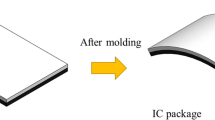Abstract
We proposed a method to determine the probabilistic fatigue-life distribution of solid state drives (SSDs) due under thermal cycling through finite element method and Monte Carlo simulation and the effect of their design and operating variables on failure through sensitivity analysis. In the developed finite element model, we utilized the Anand model to represent the viscoplastic behavior of solder balls and utilized the Prony series to represent the viscoelastic behavior of a polymer material in the underfill. In order to verify the developed finite element model, we compared the simulated strain with that measured in a thermal chamber. Using the developed finite element model, thermal cycling analysis was performed to determine the fatigue life of the SSD using the simulated results and Morrow’s energy-based fatigue model. The finite element analysis results showed that the outermost solder ball at the corner of the dynamic random access memory (DRAM), was the most vulnerable component under thermal cycling. Monte Carlo simulation was performed to analyze the fatigue life distribution according to the manufacturing tolerances of the design and operating variables of the SSD. Sensitivity analysis was also performed to determine the effects of variables on number of cycles to failure. The analysis results showed that the minimum temperature of the thermal cycling profile condition and the diameter of the DRAM solder balls dominantly affected the fatigue life of the SSD.












Similar content being viewed by others
References
Association EI, others (1989) JEDEC STANDARD: Temperature Cycling JESD22-A104-D
Chang J, Wang L, Dirk J et al (2006) Finite element modeling predicts the effects of voids on thermal shock reliability and thermal resistance of power device. Weld J 85:63–70
Chen L, Zhang Q, Wang G et al (2001) The effects of underfill and its material models on thermomechanical behaviors of a flip chip package. IEEE Trans Adv Packag 24:17–24
Evans JW, Evans JY, Ghaffarian R et al (2000) Simulation of fatigue distributions for ball grid arrays by the Monte Carlo method. Microelectron Reliab 40:1147–1155
Kim M-K, Joo J-W (2012) Thermo-mechanical Behavior of WB-PBGA Packages Considering Viscoelastic Material Properties. J Microelectron Packag Soc 19:17–28
Kim YK, Gang JH, Lee B-Y (2011) Material property effects on solder failure analyses. Microelectron Reliab 51:985–993
Lee JH, Lee MH, Kim KB et al (2015) Monte Carlo simulation of the manufacturing tolerance in FDBs to identify the sensitive design variables affecting the performance of a disk-spindle system. Microsyst Technol 21:2649–2656
Morrow JD (1964) ASTM STP 378
Mustafa M, Roberts JC, Suhling JC, Lall P (2014) The effects of aging on the fatigue life of lead free solders. In: 2014 IEEE 64th Electronic Components and Technology Conference (ECTC). pp 666–683
Pang JH, Xiong BS, Low TH (2004) Creep and fatigue characterization of lead free 95.5 Sn-3.8 Ag-0.7 Cu solder. In: Electronic Components and Technology Conference, 2004. Proceedings. 54th. IEEE, pp 1333–1337
Schubert A, Dudek R, Auerswald E, et al (2003) Fatigue life models for SnAgCu and SnPb solder joints evaluated by experiments and simulation. In: Electronic Components and Technology Conference, 2003. Proceedings. 53rd. pp 603–610
Steinberg Dave S (1988) Vibration analysis for electronic equipment. Wiley, United States of America
Yang D-G, Liang JS, Li Q-Y et al (2004) Parametric study on flip chip package with lead-free solder joints by using the probabilistic designing approach. Microelectron Reliab 44:1947–1955
Zhang L, Sun L, Guo Y, He C (2014) Reliability of lead-free solder joints in CSP device under thermal cycling. J Mater Sci: Mater Electron 25:1209–1213
Acknowledgements
This research was supported by a Semiconductor Industry Collaborative Project between Hanyang University and Samsung Electronics Co. Ltd.
Author information
Authors and Affiliations
Corresponding author
Rights and permissions
About this article
Cite this article
Cho, Y., Jang, J. & Jang, G. Sensitivity analysis on the fatigue life of solid state drive solder joints by the finite element method and Monte Carlo simulation. Microsyst Technol 24, 4669–4676 (2018). https://doi.org/10.1007/s00542-018-3819-0
Received:
Accepted:
Published:
Issue Date:
DOI: https://doi.org/10.1007/s00542-018-3819-0




